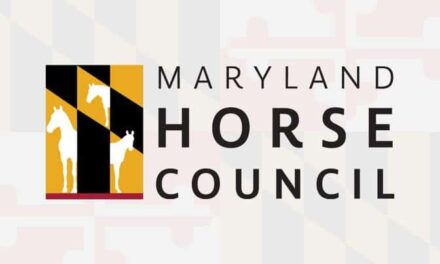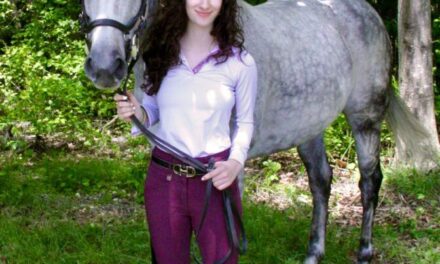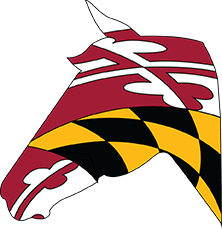First published in the July 2021 Equiery
 The Maryland Horse Council represents all aspects of Maryland’s diverse horse community and that community includes trail riders! MHC has a standing committee dedicated to issues that affect trail riders–the Trails & Greenways Committee. The Trails & Greenways Committee liaises with Maryland’s trail and greenways equestrian groups, supports recreational land uses including public trails and trail access, and provides educational opportunities for horsemen working on local land use issues.
The Maryland Horse Council represents all aspects of Maryland’s diverse horse community and that community includes trail riders! MHC has a standing committee dedicated to issues that affect trail riders–the Trails & Greenways Committee. The Trails & Greenways Committee liaises with Maryland’s trail and greenways equestrian groups, supports recreational land uses including public trails and trail access, and provides educational opportunities for horsemen working on local land use issues.
Carolann Sharpe of Country Line Farm in Reisterstown, chairs MHC’s Trails & Greenways Committee. She is a Special Education teacher, military and law enforcement wife, and the mother of four sons, in addition to being a member of MHC’s Executive Committee. As a result, Carolann said in a recent interview with The Equiery: “Trail riding has given me the mental and physical health that I need. It gives me much needed quiet time or time with friends, away from ‘real life.’ Trail riding is the one part of my life that I have one focus and one focus only… to keep the horse between me and the ground! It’s my Zen.”
Carolann gives freely of her time. She is a member of TROT, the League of Maryland Horseman, Carroll County Equestrian Council, the Professional Association of Therapeutic Horseback Riding, the Friends of Patapsco Valley State Park, and the Tuckahoe Equestrian Equestrian Center. She is also active in the PA Rangers and the Friends of Liberty Reservoir, and she volunteers with several mounted rescues throughout the state. Last but not least, Carolann gives community service opportunities to children through her bakery, Black and White Cookie Equine.
We asked Carolann to tell us a bit about the Trails & Greenways Committee and what it does for MHC and for Maryland as a whole.
Q. Who does this committee represent?
A. All MCH individual members who ride on and use Maryland’s public trails, as well as each of our association members who service the trail riding community.
Q. What are the Committee’s current goals?
A. To advise the MHC Executive Committee on the needs and perspectives of the trail riding members and to create networking opportunities among our association members that work on behalf of trail riders.
Q. What are the current goals of the Committee as it relates to the Maryland horse community as a whole?
A. Although the majority of Maryland horse people are trail riders, trail riders are often isolated from the larger Maryland horse world. As a result, one of our primary goals is to make sure that our trail riding members are fully integrated into the horse industry as a whole.
Q. Why is this committee important?
A. I’ve always thought that the Maryland horse community seems fractured and compartmentalized. We have common goals, but we don’t communicate frequently enough with each other. The Committee’s networking events will allow our members:
1. to learn more about each other’s work on trail riding issues;;
2. to share ideas and strategies for addressing concerns about trails and trail riding; and
3. to collaborate on projects and initiatives that would benefit our members from all equestrian disciplines.
Q. How can people join the committee?
A. If you are already an MHC member, just raise your hand! If you are not yet an MHC member, fill out our simple and easy membership application on the MHC website, pay your dues, and then raise your hand! Carolann can be reached at blackandwhitecookieequine@gmail.com.
A Historical Look at MHC’s Trails & Greenways Committee
The first chair of MHC’s Trails & Greenways Committee was Sol Goldstein. As a WWII veteran and successful entrepreneur and businessman, Goldstein did not discover horses until he was in his 70s. Goldstein went on to become MHC President from 1999 to 2001. He was the driving force in bringing together all trail organizations within MHC to work together under the umbrella of the Trails & Greenways Committee.
Goldstein forged a relationship between MHC and the Maryland Department of Natural Resources, and actively networked MHC into the Maryland State Highway Administration in order to access federal funds known as Transportation Equity Act for the 21st Century or TEA-21 (originally Intermodal Surface Transportation Efficiency Act of 1991 or ISTEA) for local bridle trail projects.
In addition to these projects, MHC’s Trails & Greenways Committee put together a Multi-User Trail Etiquette Brochure that was first published in 1996. “What was so interesting about this is that MHC put out the brochure as etiquette, not rules. The etiquette quickly catapulted in common parlance to ‘law’ and was duplicated as ‘official’ in numerous places as well as copied by other states,” Crystal Brumme Pickett, current MHC Secretary, stated.
Over the years, there have been several chairs of MHC’s Trails & Greenways Committee. Peggy Bree is particularly notable for the work she did in bringing together trail associations from the Eastern Shore to Western Maryland.
The most recent chair of the Trails & Greenways Committee, before it went on hiatus, was Ron MacNab, who was also president of TROT (Trail Riders of Today). TROT is one of the largest organized trail riding associations in Maryland. As the chair of the Trails & Greenways Committee and president of TROT, he was a natural fit for a new Maryland Department of Natural Resources (DNR) stakeholder committee.
“Over the course of that first year, the Committee provided feedback to DNR in preparations of a five-year trail plan for DNR properties,” MacNab stated, adding, “The plan set aside designated sustainable multi-use trails including both new construction, reconstruction and maintenance.” MacNab pointed out that the new trails in the Patuxent State Park and Seneca Creek State Park are results of this Committee’s work.
“Another fruit of this work was the development of Maryland DNR’s online free Interactive Maps and Trails Guide,” MacNab said. The guide incorporates all known trails withing Maryland and organizes them by designated use. “I am happy to say the MHC Trails & Greenways Committee was a large contributor to this effort.”












